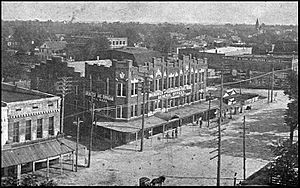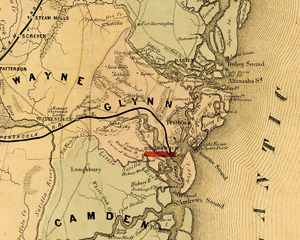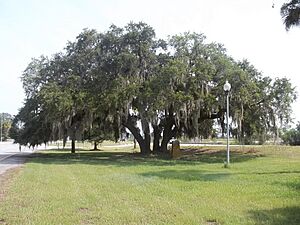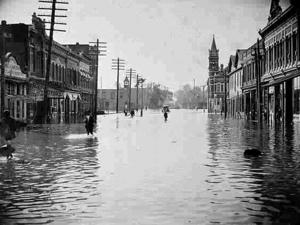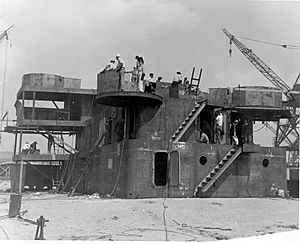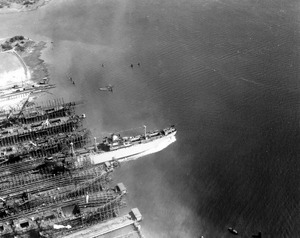History of Brunswick, Georgia facts for kids
The History of Brunswick, Georgia began in 1738. That's when a large farm, about 1,000-acre (4 km2), was started along the Turtle River. By 1789, President George Washington recognized Brunswick as one of the first five major ports for the American colonies. This was a big deal! In 1797, Brunswick became the main town, or county seat, for Glynn County. It still holds that important role today.
During the later part of the American Civil War, many people left Brunswick. Much of the city was even burned as the Union Army got closer. But Brunswick bounced back! A big lumber mill was built, bringing jobs and money back to the area. By the late 1800s, Brunswick was doing well. Even with yellow fever outbreaks and hurricanes, its port was busy with cotton, wood, and oysters. Tourists also loved Brunswick because of nearby Jekyll Island. This island was a fancy getaway for rich and famous people.
World War I brought shipbuilding to Brunswick. But the economy really boomed during World War II. About 16,000 workers built ninety-nine Liberty ships and "Knot" ships. During the war, Brunswick's Glynco Naval Air Station became the world's largest blimp base for a while. Since World War II, Brunswick has grown steadily. It's known for its deep natural port, which is the westernmost harbor on the East Coast. Recently, Brunswick even declared itself the "Shrimp Capital of the World" because of its busy shrimp industry!
Contents
How Brunswick Began
As early as 1738, the first English settler in the area was Mark Carr. He was a captain in General James Oglethorpe's boat company. Carr started his 1,000-acre (4 km2) farm along the Turtle River. This spot was known as Plug Point.
In 1771, the Royal Province of Georgia bought Carr's land. They then planned out the town of Brunswick. It was designed in a grid pattern, much like Oglethorpe's plan for Savannah. Brunswick got its name from Brunswick-Lüneburg in Germany. This was the home country of King George II of Great Britain.
In 1789, George Washington announced that Brunswick was one of the first five ports of entry for the colonies. This helped the city grow. In 1797, the Georgia General Assembly moved the county seat of Glynn County to Brunswick. It had been in Frederica on St. Simons Island.
Growing the City and Trade
Not much happened in Brunswick for 30 years after it became the county seat. The first public building, Glynn Academy, was built in 1819. But it closed four years later because not enough students attended. The school soon reopened. In 1840, a new building was put up where Glynn Academy stands today.
In 1826, Urbanus Dart and William R. Davis were given ownership of much of the undeveloped town. Soon after, Brunswick had a courthouse, a jail, and about 30 houses and stores. Dart and Davis teamed up with Thomas Butler King. He was the founder of the Brunswick and Florida Railroad. Together, they planned to build a canal north to the Altamaha River. This canal would connect Brunswick's port to farms further inland.
In 1836, the Oglethorpe House hotel was built. Two years later, a newspaper started, and a new bank opened. But a financial crisis in 1837 caused cotton and timber prices to drop. This slowed down the canal and railroad projects. The Cotton Crash of 1839 made things even worse for the city.
After a tough time, the Brunswick–Altamaha Canal opened in 1854. The railroad followed in 1856. Brunswick received its second official charter that same year. It officially became a city on February 22, 1856. By 1860, the city had 468 people, a weekly newspaper, a bank, and a sawmill.
Brunswick During the Civil War
During the American Civil War, the Confederate States Army burned the St. Simons Island Lighthouse. They did this to stop it from falling into Union hands. In Brunswick, the docks and the Oglethorpe House hotel were burned. The hotel would have been a perfect place for the Union Army to use.
When the city was told to evacuate, most people left for nearby Waynesville. The canal and railroad stopped working, and Brunswick was left empty.
After the war, Brunswick faced hard times until the 1870s. But in 1874, one of the nation's largest lumber mills opened on St. Simons Island. This brought back jobs and money. Canals and rivers were replaced by trains. The Brunswick & Albany and Macon & Brunswick railroads connected Georgia to the Port of Brunswick.
Late 1800s in Brunswick
In 1878, poet Sidney Lanier wrote his famous poem "The Marshes of Glynn." He wrote it about the salt marshes in Glynn County. Lanier was looking for relief from tuberculosis in Brunswick's climate. The Sidney Lanier Bridge, which crosses these marshes, is named after him. There's a historical marker near the marshes that honors Lanier and his poem. A large oak tree nearby is even called Lanier's Oak.
In December 1888, a magazine called Harper's Weekly predicted that "Brunswick by the Sea" would become a popular winter resort. Jekyll Island had already become a very fancy and private getaway. Rich families like the Rockefellers, Vanderbilts, and Pulitzers came to Brunswick and the Golden Isles. They enjoyed hunting, fishing, and socializing. The beautiful Oglethorpe Hotel, which opened in 1888, was a big draw.
In 1893, a yellow fever outbreak added to the problems caused by a worldwide economic downturn. Two hurricanes, one in 1893 and another in 1898, caused floods in the city. However, Brunswick quickly recovered. This was thanks to its growing port business, which handled cotton, lumber, naval stores, and oysters.
Brunswick During the World Wars
During World War I, wooden and concrete ships were built in Brunswick. These ships were designed to protect against mines. A large gunpowder and weapons factory was also built. But it wasn't finished before the war ended.
In World War II, German U-boats (submarines) were a threat along the coast. Blimps became a common sight as they patrolled the coastal areas. Blimps from Brunswick's Glynco Naval Air Station helped protect ships. At the time, it was the largest blimp base in the world. Blimps from Glynco safely escorted almost 100,000 ships. Not a single ship was lost to enemy submarines!
Building Liberty Ships
Brunswick grew very fast during World War II. Over 16,000 workers from the J. A. Jones Construction Company built ninety-nine Liberty ships. They also built "Knot" ships. These were Type C1-M ships designed for shorter trips along the coast. They were often named after different kinds of knots. These ships helped carry supplies for the war efforts in Europe and the Pacific.
The first ship built was the SS James M. Wayne. Its construction started on July 6, 1942, and it was launched on March 13, 1943. The last ship was the SS Coastal Ranger. Its construction began on June 7, 1945, and it was launched on August 25, 1945.
At first, it took a long time to build each ship. But soon, workers got much faster. Most ships were built in about two months. By November 1943, about four ships were launched each month. The SS William F. Jerman was built in only 34 days in late 1944! Six ships could be built at the same time in the slipways.
In December 1944, the United States Navy asked for six ships from each shipyard. The Brunswick workers promised to deliver seven ships! For the first 11 months of 1944, they had launched about four ships per month. They had never built more than five ships in one month before. But the workers kept their promise by working extra hours, even on Christmas Day. All the ships launched that December were finished in 34 to 42 days.
The workers even asked not to be paid for their extra work. They gave their overtime paychecks to the government. After that amazing month, they never built more than five ships in a calendar month again. The last ship, the SS Coastal Ranger, was launched shortly after the war ended.
Most of the Liberty ships from Brunswick were given to U.S. shipping companies. Many were named after famous Americans, especially U.S. Supreme Court Justices from the South. However, some ships went to Great Britain and were named starting with "Sam" (like Samdee). One ship went to the Norwegian government.
A large model of a Liberty ship was built for training workers. After World War II, it was displayed in Brunswick. But it rusted and was removed. In 1987, people started efforts to build a new model. This 23-foot (7 m) model was shown on August 23, 1991, in Mary Ross Park. A new park, called Liberty Ship Park, is being built. The model will be moved there.
Brunswick Today
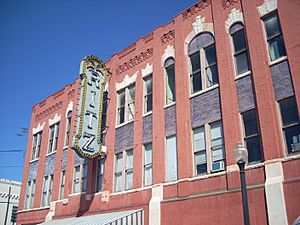
Today, Brunswick is still home to a busy port. It has the deepest natural port in the area. As the westernmost harbor on the East Coast, Brunswick is full of activity. It's also known as the "Shrimp Capital of the World."
Brunswick is home to Hercules, one of the oldest yellow-pine chemical plants in the world. Other big companies like Rich-SeaPak Corporation and King and Prince Seafood are also based here. The Georgia Ports Authority terminals bring business from all over the world.
Brunswick's Old Town is a special place. It's the largest historic district in Georgia listed on the National Register of Historic Places. Downtown Brunswick is being improved through the National Main Street Program. This helps protect and show off its unique old buildings. Events like the Old Town Tour of Homes, Concerts in the Square, the Brunswick Stewbilee, and HarborFest invite visitors to enjoy Brunswick's parks and beautiful homes.
|


